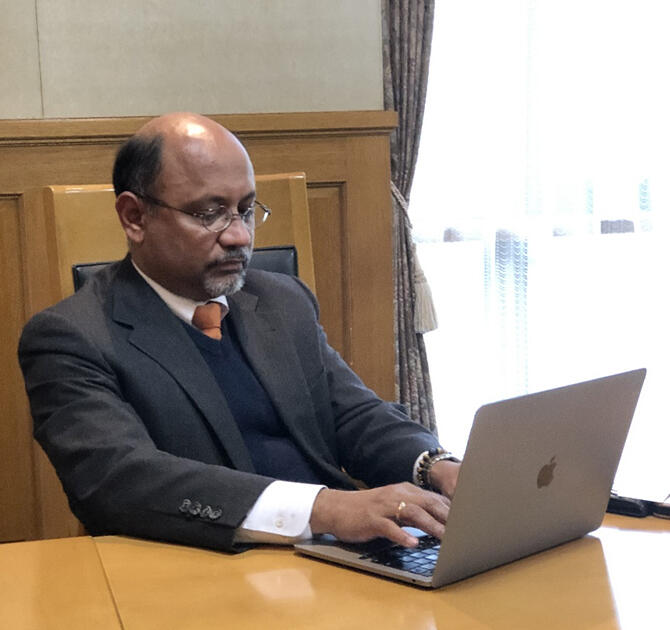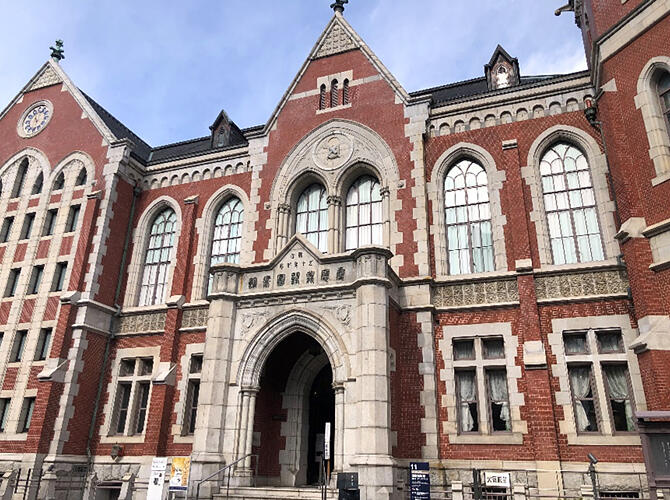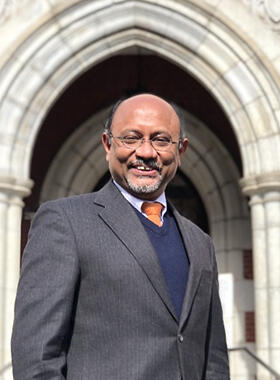This is part 2 of our interview with Dr. Rajib Shaw, a Japanese national of Indian descent working at Keio University in Japan. We pick up from learning of how he found his way into a career in research, and his journey towards working in Japan.
Linking research with outreach and the impact of global initiatives
These days Prof. Shaw is working hard in four broad areas of research. The first is urban resilience, looking at the differences between rural and urban areas, as well as the differences between people who live in urban areas, such as the rich and poor, and so on. The second is innovation in climate change adaptation, especially innovation seen in rural areas and different kinds of ecosystems. Third is risk communication or 'disaster education', but he added that it is less like a 'lecture' and more like a two‐way channel of communication. The fourth and final area is entrepreneurship in the field of disaster risk reduction and climate change adaptation.
Through his research he has been involved with several of the well‐known global initiatives in these areas. He specifically mentioned three that are particularly important. "There are three agreements related to my work. The first is the Sustainable Development Goals or SDGs. These days you will see the badge everywhere, and everyone talks about them, whether you understand it or not 'SDGs!' The next is the Paris Agreement, and the final one is the Sendai Framework for Disaster Risk Reduction." According to Prof. Shaw these three agreements, one each for development, climate, and disasters respectively, are all interrelated. After the agreements were signed, he undertook a study on each document and found an interesting result. Across each of the agreements the word 'local' was used consistently, and this underlies what Prof. Shaw believes is truly where the real groundwork to advance each of the agreements is being done. "Our main argument was that global frameworks are important, but when it comes to actual implementation, local action is what is truly required."
This interlinkage between important global frameworks was highlighted by the impacts that the COVID‐19 pandemic had on communities around the world. Every year Prof. Shaw analyzes the top issues brought up at the Davos Economic Forum and noticed some very interesting impacts. In 2020 the digital divide and health risks was the top issue, and this is tightly linked with Prof. Shaw's research into urban resilience and urban vs. rural areas. "While we now have work from home, digital education and healthcare, zoom calls, and such things, we do not have them everywhere. Some places don't have the required connectivity." This is not just an issue faced by developing countries, but even within developed countries, Prof. Shaw added, "[This is visible between] Global North or South nations, urban and rural areas within the same country, or even between age groups. The younger generations are digital natives, but the older generations, if you say, 'Digital Healthcare' they will simply respond with "What?" So, we see that this digital divide is increasing."
These sudden changes shine a light on the issue of a 'changing risk landscape', and the huge impact that this has on the indicators and goals that were set out in each of the global agreements. "When we talk about particular indicators, we say with a certain amount of pressure that we will be carbon neutral by 2050, but we don't fully understand the uncertainty around these, and we can't always predict how the global landscape will change." Prof. Shaw's work into urban resilience, innovation, and disaster education ties strongly into these issues and will likely be a driving force towards limiting the impact that the changing risk landscape, and issues such as the digital divide are posing towards the achievement of lofty global initiatives.

Combining the strengths of India and Japan
As a Japanese national of Indian origin, Prof. Shaw is uniquely placed to share his insights into each country's research environment. However, he believes that it is not fair to compare the two countries. "I don't know whether it is fair to compare, or fair to use this word 'compare'." If you quickly look at each country, it is easy to see why Prof. Shaw has this opinion. "The context is quite different; the numbers are different. If you think about the quantity, the number of research opportunities is much higher in India. If you think about quality, maybe then that is higher in Japan."
He linked this idea back to a fundamental difference in the mindset between researchers in each country. In India, the concept of Jugaad underlies a lot of the research that is undertaken. "Jugaad means an improvised solution. For example, your car has broken down, the most important thing is that you need to make that car go, however you do it. So, it is not a perfect solution, but you do whatever you have to, to make it go." This improvised Jugaad solution contrasts with the controlled and methodical practices seen in Japan, which is known as "Kaizen". The product must be tried and tested before being brought to market. While this provides the 'made in Japan' brand quality that is famous around the world, it may mean that the product loses the cutting‐edge aspect required in today's global world. The underlying vibration is quite different, and Prof. Shaw believes that bringing these two mindsets together could provide an ideal platform for the combined development of science and technology innovation.
Trying to make use of his unique position, Prof. Shaw now runs an India‐Japan lab where the students work with universities in India. "We are trying to develop incubation centers in different universities specifically targeting SDGs climate and disasters. If these students have excellent ideas, we try to request monetary or mentoring support (From FICCI or the Keidanren or other development agencies) to turn some of these ideas into actual reality"
Prof. Shaw also had three points of advice for those hoping to work and/or do research here in Japan. First, "People have this notion of barriers in Japan, both language and cultural. It may possibly have been like that 30‐40 years ago, but these days I strongly disagree with this idea. Come to Japan with an open mind" His second point was to be aware that the quality of life, education and research is extremely high. The final piece of advice was despite the stereotypes, Japan is a great place to design your own path as a researcher, that it will open many doors and give you a lot of opportunities for growth as a researcher.
Towards 2050 and the future of disaster and climate change research
Prof. Shaw spoke passionately about the role that young people, particularly young researchers will play in the future. "Unless we motivate young professionals to undertake more disruptive challenges, the subject will not grow" he said enthusiastically. He was part of the establishment of a youth alliance called U‐Inspire, which was done in collaboration with UNESCO and is focused in the Asia and Pacific regions. Through the alliance, youth groups are encouraged to work towards disruptive research and action projects. Prof. Shaw plays the role of an advisor and spoke about what he thinks is important about the initiative, "Youth can play such an important role. There have been a lot of climate protests or activism, which I don't say are not required, but my main interest is mobilizing youth towards a more positive side of action." Prof. Shaw tries to provide an ecosystem that helps match youth with big ideas, with the funding and support that they need to achieve them.
He also touched on his desire to establish a global technology innovation hub in Keio University. "There are three main types of technologies that are present in the risk reduction and climate change fields. The first are the emerging technologies, those that will make a big splash and become the essential technologies of tomorrow. Second are the conventional technologies, such as earthquake engineering or flood risk reduction technologies. The final type is local, or indigenous knowledge, they are not necessarily technologies but have been in use for a long time." Prof. Shaw hopes to set‐up this hub and get to work using these technologies within the year.
As a final point, Prof. Shaw underlined the fact that it is local communities, and the people living there, that ultimately decide how effective risk reduction research is, stating, "My intention is always that I am not there to tell them what to do, but that I am there to work with them and learn with them. I do not wish to impose anything on them from outside. Understanding the situation is the first important thing. The second is to gain the trust of the community. When people take real ownership of the solution, then they become very proud of it. That is possibly the best way of achieving sustainability"

The work being done by researchers like Prof. Shaw continues to make a huge impact on the daily lives of communities which have been struck by disaster, and also communities in developing countries. The disruptive, emerging technologies of tomorrow have the potential to create more resilient communities, and to make the lives of those living in climate affected regions more comfortable and sustainable. The Science Japan team expect that Prof. Shaw will continue to work towards more resilient and sustainable communities and looks forward to seeing more of his research outcomes in the future.

Profile
RAJIB Shaw
A Japanese national of Indian origin, completed his undergraduate studies in India. After receiving the MEXT scholarship and completing his studies in Japan, he moved into a consulting role where he was heavily involved with Japan's overseas disaster operations. He then took up a position in Kyoto University, Japan and has been in his current role as a professor at Keio University since 2017.
A list of Prof. Shaw's research results can be found at the following link: https://rajibshaw.org/research/publications/
Prof. Rajib Shaw: https://rajibshaw.org/profile/
Produced by the Science Japan Editorial Team



